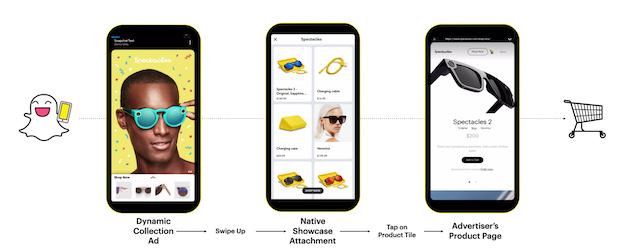Everything You Need To Know About Social Media Product Feeds

If you’ve noticed an increasing number of brands embracing the world of social commerce, you’re not alone. Gone are the days of having to actually go to a brand’s website to purchase a product. Now, with social commerce activations in place, consumers can seamlessly browse and buy products within social media platforms.
There’s no denying the trend of social commerce is on rise. In fact, social commerce sales in the U.S. are forecasted to exceed $45 billion in 2022, a ~25% increase over 2021’s already-impressive YoY growth. A recent study from eMarketer also shows social commerce sales are expected to reach $79 billion-plus by year-end 2025.

As we see social commerce continue to gain momentum, it’s incredibly important that brands not only have fun and fresh content in place, but foundational elements in place as well. That’s why having a solid social media product feed should be a critical component in both your overall social commerce strategy and advertising strategy.
In this article, we’ll break down everything you need to know about social media product feeds like:
Let’s start with the basics…
A product feed is essentially a collection of data that contains all available products a specific merchant sells. This information is organized within a file that includes product attributes like product title, description, size, color, price, and more. Check out the example from Facebook below.

While the feeds themselves may not sound or look glamorous, they are the backbone of ecommerce and social commerce. But, how do social media product feeds actually function?
As we briefly mentioned, shopping and social feeds, sometimes known as product catalogs, house all of a brand’s products and product attributes in corresponding files. These feeds – and the information they house – are used to sync products to various platforms for paid advertising including Google Shopping, Facebook Ads, Instagram Ads, remarketing ads, and more. Aside from paid activations, these feeds can also be used to sync products to a variety of social marketplaces where brands would like their products featured.
Think of Instagram Shops for example. For each Shop you see, or tagged product you see, a feed was used to upload product information (but more on that later). Product feeds can be managed manually or with the help of a software system like Feedonomics, a platform we use at Tinuiti.

Let’s dive into a quick example of our internal product feeds process…
Once a Tinuiti client has sent over their product data, our feed experts get to work within Feedonomics to clean-up and complete that data as needed:
While most social platforms accept a Google Shopping feed, as Google is the largest feed-based advertiser, we recommend creating specific feeds for each social platform on which you’ll engage in social commerce. Because there are differences between platforms—such as how long a product name can be before it gets truncated—creating feeds optimized for each platform’s specific attribute details will result in a more polished look and feel that encourages click-through.
Each social media platform has both required and recommended attributes that need to be included in a product feed, but what are their differences? Required attributes are those that you must include for a feed to be accepted by a platform. Some examples of required attributes (for most platforms) include:
If you don’t include recommended attributes, the data feed will still upload, but many social platforms encourage including these additional attributes to further optimize campaigns. Examples of recommended attributes include sale price, size, gender, custom labels, and more.
Make sure to check out both the required and recommended attributes for each social channel before uploading a feed to save time in the long run.
Let’s take a look at some of the top social media platforms and how feeds come into play within each. We’ll share how these feeds work, need-to-know insights, and a few real-world examples of each.

Facebook product feeds are known as product catalogs within the platform. These catalogs house a brand’s product information and allows them to run dynamic ads across both Facebook and Instagram. By having a Facebook product catalog in place, brands can eliminate the step of creating individual ads and they can access a variety of commerce products (on both Facebook and Instagram) like:
Dynamic Product Ads – Facebook dynamic ads automatically show the right products to people who have expressed interest on your website. Pair DPA with product tags to integrate even further with Facebook commerce offering.
Product Tags and Ads – Tag products from a Facebook shop or catalog in posts and ads. When people see your products tagged in your posts, they can select those tags to start shopping.
Live Shopping – Live Shopping on Facebook is an interactive way to sell items, connect directly with viewers, and gain potential customers, all in real-time as you feature and demonstrate your products.
Shops – Make it easier for businesses to set up a digital storefront (aka ‘Shops’) and sell items online.
Ads in Explore – Reach people in the discovery mindset who are looking to get inspired
Checkout – Checkout allows customers to buy items directly from a shop on Facebook or Instagram, directly from a brand’s Shop page. Currently, this is available only in the US and for whitelisted brands only.
Product Launches – Build anticipation with reminders and make it possible for customers to follow upcoming launches from the brands that they love.
Product Detail Pages and Collections – Detail and organize specific products within a shop by category so customers can find specific items more easily.
Each field in a data feed highlights specific information about a brand’s products. Meta requires merchants to include the following mandatory attributes within product catalogs including: product ID, item group ID, description, title, image link, link, availability, price, category, condition, and brand. If these attributes are loaded incorrectly, or not at all, products may not upload properly into the catalog.
Click here for more information on how to create and upload a Facebook or Instagram catalog.
Snapchat is no longer just for sending quick pictures and messages. The platform allows merchants to upload a product feed manually or automatically so users can browse and purchase products within the app. Once a feed is uploaded, brands can use this data to automatically create a variety of ads within Snapchat Ads Manager to reach consumers via:
Source: Snapchat

Snapchat requires the following fields in order to upload a product feed to a catalog: ID, Item Group ID, title, description, link, image link, availability, price, and brand. Recommended fields include: age group, color, condition, gender, and more.
Learn more about creating a Snapchat Catalog here.
Pinterest serves as a hub for inspiration. From decor to fashion to wedding inspo – they have it all. The platform is also a fantastic way for consumers to browse through and purchase a variety of products. To submit a product feed to Pinterest, brands need to provide Pinterest with a URL link where they can access the feed file. They then validate the file and create a product Pin for each item that passes their validation. Once the feed is uploaded, brands will have access to their catalog and product groups. From there, merchants can promote product groups via Pinterest shopping ads.

Pinterest requires the following fields in a product feed to upload properly: ID, item group ID, title, description, link, image link, price, and availability. Recommended fields include: age group, color, gender, material, pattern, size type, and more.
Click here for more information on creating shopping ads (including a step-by-step tutorial).
TikTok is gaining traction in the social commerce world by allowing brands to upload product feeds to their “catalog.” The platform gives merchants the option to upload data feeds manually, through a data feed schedule, or by uploading a file. Adding products to a TikTok catalog allows brands to create Dynamic Showcase Ads that feature relevant products to target audiences and display current product information, like availability, pricing, and more to potential buyers.

The following fields must be included in a product feed to be uploaded to a TikTok catalog: ID, item group ID, title, description, availability, condition, price, link image link, and brand. Recommended attributes include: gender, color, material, pattern, shipping fee, shipping weight, size, additional image link, google product category, and product type.
Click here for more details on creating and managing TikTok catalogs.
There’s no denying consumers spend a large portion of their time on social media each day. In fact, “as of 2022, the average daily social media usage of internet users worldwide amounted to 147 minutes per day (Source).” By having social media product feeds in place, you can make it easier for potential customers to find your products. When utilizing product feeds, you also have the ability to access a large variety of social commerce products that can better reach target audiences (ie: dynamic social ads, live shopping, etc.).
Product feeds are also the best way to keep product information up to date in a designated hub. Availability can change at a moment’s notice and tracking and updating this information all in one place will save you time and money.
Think your product feeds are in tip top shape? Check out our following recommendations for optimizing your social media product feeds so you can get more eyes on your advertisements.
Think of the product feed you provide to a platform as the connective tissue between your product information and your shoppable ad formats on a social platform. The feed knows what products look like (image URLs), what products are in stock (availability), how much the item costs (price), and more. If your source of truth isn’t accurate, the performance of your posts and ads can be negatively impacted by outdated information.
Timely price and availability updates are essential low-hanging fruit; you don’t want to spend money or time on ads that incorrectly promote higher prices and out-of-stock products. If you have a 3-day-sale, for example, and your product feed is only updated once per week, your customers won’t see your sale pricing during a crucial time period for your business.
If you don’t send a feed with updated inventory levels, you could spend money on ads that are driving customers to products with no inventory. This is why it’s important to not only maintain accurate and optimized feed information, but to share that information as frequently as possible with every feed-based platform you work with. This creates a better user experience, while also making the most of your ad dollars.
Stay away from general or vague titles as they can impact performance. We recommend keeping product titles short and highlighting the most important part of the product at the front of the title (ie: style, color, etc.). When it comes to descriptions, use the allotted character count to highlight relevant/updated product features.
It’s also incredibly important to optimize your images. This is the first aspect of an ad that grabs a consumer’s attention – make it count. Each product in a data feed should have a corresponding image in the proper format and size per the platform’s requirements. The image should be high quality and should clearly represent the product including any stand-out features.
Testing should be a critical part of every marketing campaign, but it’s especially important when it comes to product feeds. We recommend conducting A/B testing with a variety of product feed attributes, as mentioned above. For example, it’s a great idea to test out different product titles and different imagery (lifestyle images vs. standard product images) to see what performs better in social commerce ad formats.
“In feed-based ads, your product data is your creative. It’s incredibly important to run tests across all social platforms to understand which variation performs the best for that unique experience and audience. A lifestyle image with a detailed title may perform well for one social platform, but users on another may be more drawn to short titles with stock photos. Working alongside your merchandising team and other feed-based channels, like Google Shopping or display retargeting, to share learnings from these types of tests is crucial in developing a holistic, multi-channel product data feed strategy to help you achieve your business goals.”

– Ashlee Wiltshire, Senior Director, Shoppable Media
When it comes to product feeds, consider custom labels the secret sauce of campaign optimization. Custom labels are considered an ‘optional’ field for Facebook and Instagram campaigns, but we highly recommended implementing them. Custom labels are tags that you can add to individual products that might include: high-margin items, upcoming sale items, all newly released products, bestsellers, and more.
“For example, a sale-priced shoe that is in stock—but only has inventory for the least popular sizes—might perform worse in an ad than a shoe that has the most popular sizes in stock. While the product feed just says “in stock” for both examples, custom labels that rely on knowledge about your products/customers can be used to label the products differently, and segment them into different ad sets. These are the types of strategies that connect the product feed, strategic merchandising, and social commerce strategy.”

– Mike Wojciechowski, Senior Director, Shoppable Media
No problem! Managing and optimizing product feeds takes a lot of time and energy. We know first-hand that getting your feed in order—and ensuring you maintain an accurate, regularly updated, optimized feed—is essential to social commerce success. At Tinuiti, our Paid Social team works in collaboration with our Shoppable Media team’s feed experts to create individual social feeds that leverage that data in a platform-optimized way.
If you’re interested in learning more about our paid social or shoppable media services, contact us today.
